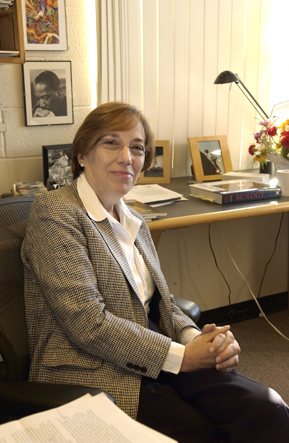Boston University Remembers Mary Erskine
Biology professor and former UROP director succumbs to cancer

Mary S. Erskine, a College of Arts and Sciences professor of biology and former director of the Undergraduate Research Opportunities Program (UROP), died on December 12, 2007, following a long battle with breast cancer. She was 61 years old.
“The Boston University community has lost an exceptional scientist, teacher, and dear friend,” says Erskine’s longtime colleague Michael Baum, a CAS professor of biology. “Mary was one of the most optimistic and friendly people I knew. She had a lively sense of humor, and she always had a smile on her face.”
Best known for her research in the area of mating behavior in rats, the behavioral neuroscientist was “a pioneer for women in the scientific community,” Baum says. Erskine came to BU in 1985 as a research assistant professor, and in 1990 she was appointed Clare Boothe Luce Professor of Biology — a professorship funded by the Luce Foundation that recognizes outstanding women in science. Her research involved the application of a wide variety of behavioral, neural, and physiological techniques to questions of how an organism’s behavior brings about changes in its own physiology. “During a time when so many women were likely to take soft-money and less-secure positions to be with their husbands, Mary made the transition from a self-supporting non–tenure track professorship to a regular tenure track,” Baum says.
Born in St. Louis, Mo., in 1946, Erskine received a bachelor’s degree from Ohio’s Hiram College. An accomplished flutist, she attended on a music scholarship, but eventually switched her major to biology. After graduation, she worked as a research technician at Stanford University Medical School, publishing a series of scientific papers that linked activity in the pituitary-adrenal axis to the display of aggressive behavior in rats. She studied endocrinology and reproductive physiology at the University of Connecticut, earning a doctorate in 1978, and during her postdoctoral training in UCLA’s department of psychiatry, she studied the development of physiological responses to stress. She later moved to Baum’s lab at MIT, where she received a postdoctoral fellowship from the National Institutes of Health (NIH) for the study of neuroendocrine control of behavior.
In 1985, Erskine followed Baum to BU, where as a research assistant professor she continued to obtain her own NIH funding to support research. She achieved tenure in 1995 and was promoted to full professor in 1999. As a senior woman in the biology department, Erskine was “a mentor and role model for many female students and postdoctoral fellows who sought to establish careers in science,” Baum says. “She proved that women could have both a family and a successful career.”
Although diagnosed with metastatic breast cancer in 1999, Erskine continued to advance her research career by developing an entry-level course for biology undergraduates specializing in neuroscience. In 2004, she was appointed director of UROP, a University initiative that promotes participation by undergraduates in faculty-mentored research university-wide; she held the position for more than two years.
“Mary was a brilliant but humble scientist,” Baum says. “Even after she received tenure, she did experiments by herself, which a lot of senior science faculty with good-size labs won’t do. They delegate it to the students; she never did.”
Erskine is survived by two sons, Samuel Bridges and Mark Bridges (CFA’06). A memorial service was held at Marsh Chapel on January 14. Contributions to the Mary Erskine Undergraduate Research Award may be sent to Deirdre James, CAS Biology Department, 5 Cummington St., Boston, MA 02215; 617-358-4825 or dejames@bu.edu.
Vicky Waltz can be reached at vwaltz@bu.edu.
Comments & Discussion
Boston University moderates comments to facilitate an informed, substantive, civil conversation. Abusive, profane, self-promotional, misleading, incoherent or off-topic comments will be rejected. Moderators are staffed during regular business hours (EST) and can only accept comments written in English. Statistics or facts must include a citation or a link to the citation.